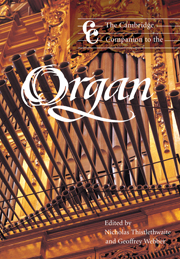4 - Temperament and pitch
from Part I - The instrument
Published online by Cambridge University Press: 28 September 2011
Summary
Temperament
It is not improbable that a high proportion of the readership of this book will have accepted early in their musical education the principle of an octave being divided into twelve semitones of equal size, implicit within this being the notion of enharmonic notes and equal temperament tuning. Yet the second half of the twentieth century has seen an increasing preoccupation on the part of musicians with matters relating to heightened stylistic awareness in performance. Amongst players and makers of keyboard instruments quests for ‘historically informed’ or ‘authentic’ performances include the issues of pitch and temperament. For the organ, unlike the pianoforte, equal temperament tuning has been the universal norm for barely a century, but the current desire for enlightened performances of the pre-romantic repertoire has seen the rehabilitation of historically appropriate systems of tuning. As the keyboard instrument with the widest repertoire, the organ also has the richest heritage of historic instruments and artefacts. The issue of temperament is therefore of considerable significance with regard to restorations and for new instruments which seek to replicate historical styles.
The scope of this chapter is such that it can only attempt to provide an introduction to the concept and history of a very large and complex subject. The plan is threefold: first, to consider the principles of temperament, secondly, to consider three historically important systems (equal temperament, mean-tone temperaments, irregular temperaments), and thirdly, to consider the subject chronologically in relation to the repertoire and modern performance conditions.
- Type
- Chapter
- Information
- The Cambridge Companion to the Organ , pp. 42 - 54Publisher: Cambridge University PressPrint publication year: 1999
- 1
- Cited by



